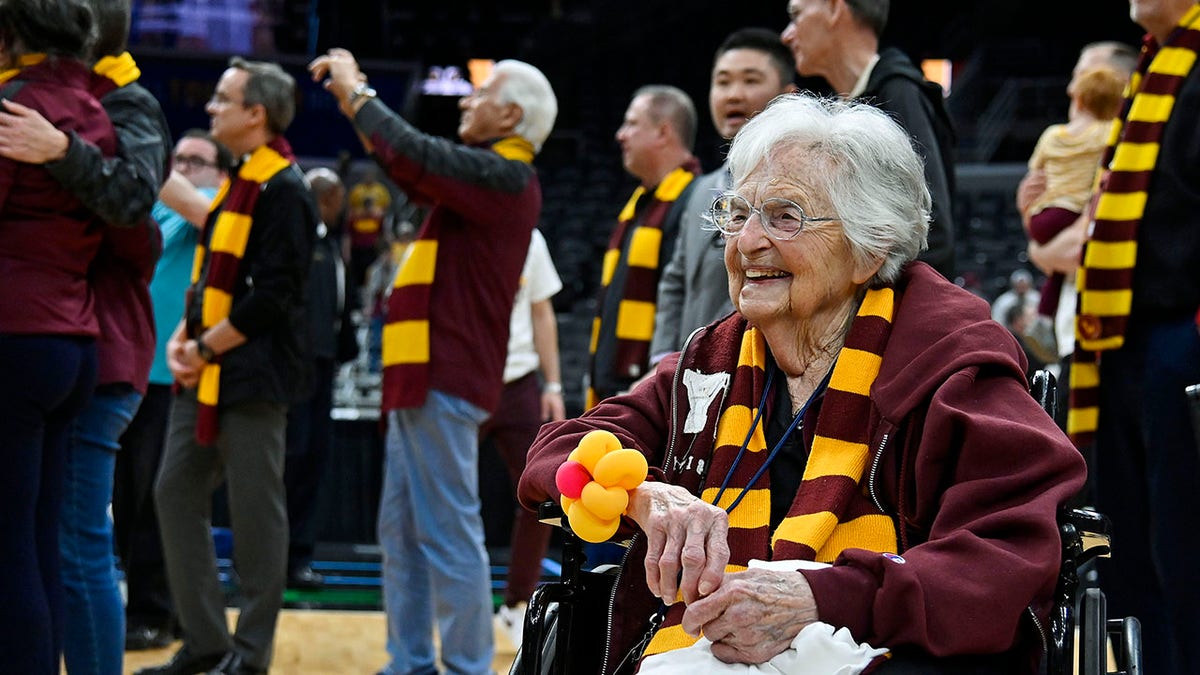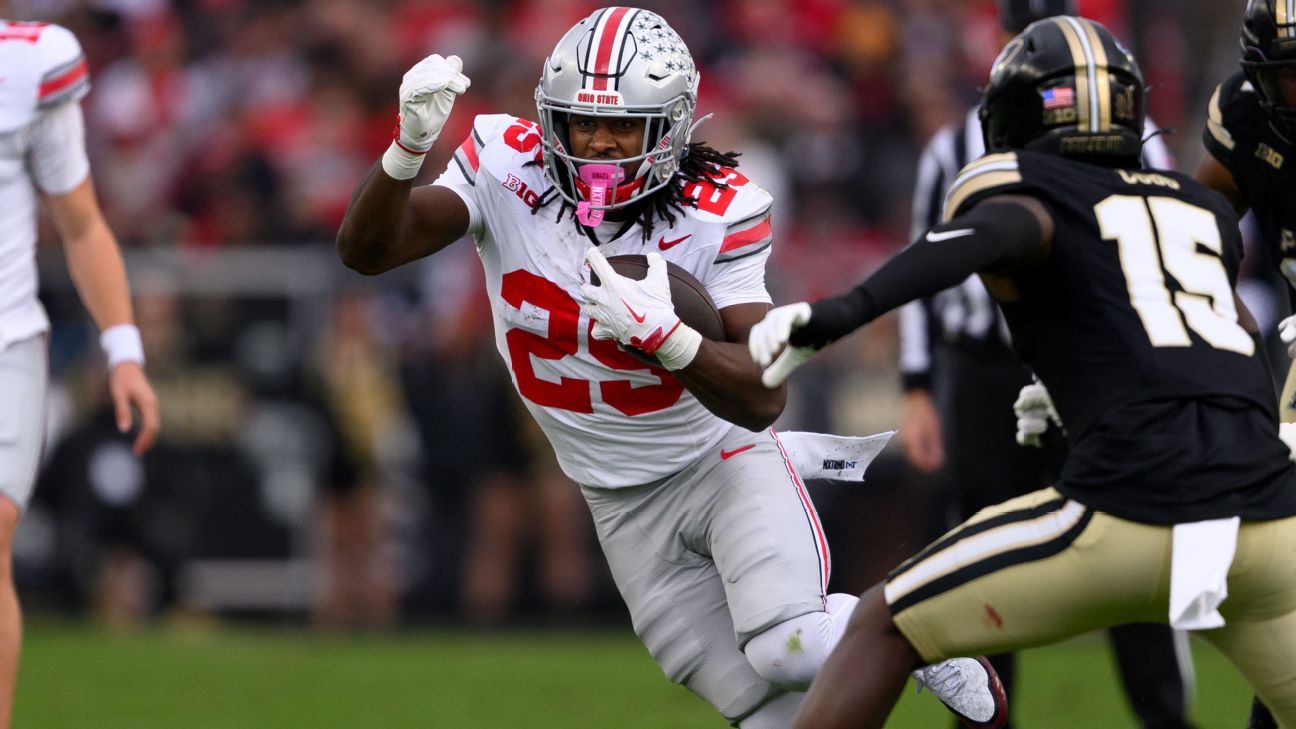Sports
Sister Jean retires as Loyola Chicago basketball chaplain due to health concerns

NEWYou can now listen to Fox News articles!
Sister Jean Dolores Schmidt, the beloved chaplain for Loyola Chicago’s men’s basketball team, is retiring at 106 years old due to health concerns, according to the school’s student newspaper.
Sister Jean, who has become a staple in the college basketball community and an important member of the Ramblers’ family since first being named team chaplain in 1994, has entered retirement just weeks after celebrating her 106th birthday.
Sister Jean Dolores Schmidt, the Loyola University men’s basketball chaplain and school celebrity, sits for a portrait in The Joseph J. Gentile Arena, on Jan. 23, 2023, in Chicago. (AP Photo/Jessie Wardarski)
Vice president of communications Christian Anderson confirmed to The Loyola Phoenix earlier this month that Schmidt would no longer serve in official duties. He did not expand on Sister Jean’s health concerns.
CLICK HERE FOR MORE SPORTS COVERAGE ON FOXNEWS.COM
“Sister Jean is retiring and stepping back from official duties at Loyola,” Anderson told the student newspaper. “We are mindful of Sister’s privacy in regards to health and can’t comment beyond what was mentioned in her [Aug. 21] message.”
In a message to the student body on her birthday, Sister Jean explained her absence on campus.
“Birthdays are special days, and this one is also very special. In fact, I am unable to be there because I have a bad summer cold and other health issues so it has been decided that I should not go to Lake Shore Campus to be with you on my birthday. That makes me very sad, but you can still celebrate.”

Sister Jean looks on as the Loyola Ramblers defeat the Drake Bulldogs in the finals of the Missouri Valley Conference Tournament at Enterprise Center on March 6, 2022. (Jeff Curry/USA Today Sports)
Sister Jean served as the team’s chaplain for 30 years, but came into the spotlight during Loyola’s improbable Final Four appearance in the 2018 NCAA championship tournament.
In 2023, she traveled to New York for the team’s first-round matchup in the Atlantic 10 Conference tournament. She was 103 when she made the trip.
During that trip, she made an appearance on “Fox & Friends,” where she shared the three simple things she attributes to living a long and healthy life.

Sister Jean Dolores Schmidt speaks to the press during her 103rd birthday celebration at her new namesake, Sister Jean Dolores Schmidt, BVM Plaza, next to the Loyola Red Line station in Chicago, on Aug. 21, 2022. (Tyler Pasciak LaRiviere/Chicago Sun-Times via AP)
CLICK HERE TO GET THE FOX NEWS APP
“Well, I tell people when they ask me that question that I eat well, I sleep well and, hopefully, I pray well,” she said at the time.
“My basketball team, it keeps me young. All these young people keep me young at heart. I can’t walk, but they keep me young at heart,” she added.
The Associated Press contributed to this report.
Follow Fox News Digital’s sports coverage on X, and subscribe to the Fox News Sports Huddle newsletter.
Sports
Potential fatal flaws that could sink 26 playoff contenders

It was an “almost” sort of Saturday in college football. No. 2 Indiana flirted with disaster at Penn State but survived thanks to an Omar Cooper Jr. toe tap. No. 9 Oregon nearly got Iowa’d but saved itself with an Atticus Sappington field goal. Auburn came close to actually winning a close game against a ranked team for once but got Diego Pavia‘d in overtime and couldn’t respond. We even had almosts at the FCS and Division II levels, where top-ranked teams North Dakota State and Ferris State each trailed late but rallied.
Granted, we still got some upsets. Two more top-15 ACC teams fell (in what feels like a weekly occurrence), No. 23 Washington fell to 2-6 Wisconsin in drizzly Madison, and Hawai’i knocked San Diego State out of playoff contention late Saturday night. Lord knows the ACC race doesn’t make any more sense than it did a week ago, but Week 11 wasn’t quite as chaotic as it could have been, and it ended up offering us a decent amount of clarity in the College Football Playoff hunt.
Using the same average CFP odds formula that I used last week — combining those of the Allstate Playoff Predictor with my own odds derived from SP+ — we now have eight teams with at least an 81% chance of making the field of 12. Loads of teams are in the hunt for those other four (or so) spots, but with three Saturdays remaining before Championship Week, let’s again break contenders into tiers and talk about their most toxic traits, the flaws that will likely keep them from either winning the national title or reaching the CFP at all.

Playoff contenders’ fatal flaws
Tier 1
At a combined 28-0 with a 95% (Indiana), 75% (Ohio State) and 49% (Texas A&M) chance of finishing the regular season 12-0, respectively, these three teams are just about at the finish line when it comes to sealing playoff bids. Indiana needed all 60 minutes to get to that point at Penn State, however. For these teams, we’re definitely gauging fatal flaws in terms of what will prevent them from winning the national title; almost nothing will prevent them from reaching the CFP.
![]() Indiana (average CFP odds: 99.9%): Big-play glitches. Indiana has had a dynamite defense since Curt Cignetti and coordinator Bryant Haines moved to Bloomington, but when the Hoosiers give up a successful play, it’s a very successful play. Usually that comes via run defense — as evidenced by a 59-yard run for Penn State’s Nicholas Singleton on Saturday — but IU also gave up six completions of 19 or more yards against an iffy PSU passing attack, and, combined with an ill-timed interception from Fernando Mendoza, it almost cost them their unbeaten record.
Indiana (average CFP odds: 99.9%): Big-play glitches. Indiana has had a dynamite defense since Curt Cignetti and coordinator Bryant Haines moved to Bloomington, but when the Hoosiers give up a successful play, it’s a very successful play. Usually that comes via run defense — as evidenced by a 59-yard run for Penn State’s Nicholas Singleton on Saturday — but IU also gave up six completions of 19 or more yards against an iffy PSU passing attack, and, combined with an ill-timed interception from Fernando Mendoza, it almost cost them their unbeaten record.
![]() Ohio State (99.6%): A merely decent run game. Indiana’s combined playoff odds are ever-so-slightly higher than those of top-ranked Ohio State, primarily because the Hoosiers only have two remaining regular-season games left and the Buckeyes have three (including one against 7-2 Michigan). But OSU is indeed the top-ranked team per both the computers. It’s not hard to see why: The defense ranks first nationally in points per drive and yards per play, and the offense features the best receiver in the country (Jeremiah Smith) and a quarterback completing over 80% of his passes (Julian Sayin).
Ohio State (99.6%): A merely decent run game. Indiana’s combined playoff odds are ever-so-slightly higher than those of top-ranked Ohio State, primarily because the Hoosiers only have two remaining regular-season games left and the Buckeyes have three (including one against 7-2 Michigan). But OSU is indeed the top-ranked team per both the computers. It’s not hard to see why: The defense ranks first nationally in points per drive and yards per play, and the offense features the best receiver in the country (Jeremiah Smith) and a quarterback completing over 80% of his passes (Julian Sayin).
Sayin will face plenty of elite defenses down the stretch, however — Michigan ranks ninth in defensive SP+, likely Big Ten championship opponent Indiana ranks fourth despite the big plays, and the CFP will obviously feature lots of good defenses — and there’s a chance the Buckeyes are rendered one-dimensional at some point because of a run game that ranks 19th in rushing success rate* but doesn’t really go anywhere (4.7 yards per carry). Sayin could carry the offense anyway, but he’s still a redshirt freshman.
(* Success rate: how frequently an offense is gaining 50% of necessary yards on first down, 70% on second and 100% on third and fourth.)
![]() Texas A&M (99.3%): Run defense. A&M once again proved its versatility on Saturday. The Aggies thumped a Missouri team that was admittedly without starting quarterback Beau Pribula — third-string freshman Matt Zollers was a dire 7-for-22 passing — but they showed off a wonderfully spaced passing game and an elite pass rush, and after a poor first half, the run game showed up in the second half, too. But even with no pass threat, Mizzou rushed for 207 yards, furthering a scary trend: A&M ranks 130th in yards allowed per carry (no sacks). I’m really struggling to see them winning three or four straight playoff games with that anchor dragging them down.
Texas A&M (99.3%): Run defense. A&M once again proved its versatility on Saturday. The Aggies thumped a Missouri team that was admittedly without starting quarterback Beau Pribula — third-string freshman Matt Zollers was a dire 7-for-22 passing — but they showed off a wonderfully spaced passing game and an elite pass rush, and after a poor first half, the run game showed up in the second half, too. But even with no pass threat, Mizzou rushed for 207 yards, furthering a scary trend: A&M ranks 130th in yards allowed per carry (no sacks). I’m really struggling to see them winning three or four straight playoff games with that anchor dragging them down.
Tier 2
All of the teams in Tier 2 have one loss; four are part of either the Big Ten or SEC, while Texas Tech lands here both because of its overwhelming quality (the Red Raiders remain fourth in SP+) and its increasingly likely Big 12 title push. Only James Madison (74%) can top Tech’s 71% conference title odds, per SP+. There’s still a chance that one of these five teams misses the dance, so we’ll say fatal flaws mean a couple of different things here.
![]() Texas Tech (average CFP odds: 90.1%): Quarterback. On one hand, Tech has played a pretty weak schedule featuring only two SP+ top-40 opponents. On the other hand, after Saturday’s win over BYU, the Red Raiders have beaten those two opponents by a combined 63-17. The dream season rolls on in Lubbock. But the school of Patrick Mahomes and the Air Raid’s legacy is still merely good throwing the ball, not great. Behren Morton is (A) injury-prone and (B) only 45th in Total QBR, and while the Red Raiders have scored 34 or more eight times, they’re 53rd in three-and-out rate and are mortal against good defenses.
Texas Tech (average CFP odds: 90.1%): Quarterback. On one hand, Tech has played a pretty weak schedule featuring only two SP+ top-40 opponents. On the other hand, after Saturday’s win over BYU, the Red Raiders have beaten those two opponents by a combined 63-17. The dream season rolls on in Lubbock. But the school of Patrick Mahomes and the Air Raid’s legacy is still merely good throwing the ball, not great. Behren Morton is (A) injury-prone and (B) only 45th in Total QBR, and while the Red Raiders have scored 34 or more eight times, they’re 53rd in three-and-out rate and are mortal against good defenses.
![]() Ole Miss (87.7%): The run game is a wash. Trinidad Chambliss‘ emergence at quarterback has given Ole Miss another dimension, both passing efficiently and running well at times. But even with Chambliss, and even with Kewan Lacy ranking 10th nationally in rushing yards (first in rushing TDs), Ole Miss still averages only 4.8 yards per carry while allowing the same. They have big advantages in the passing game (8.7 yards per dropback, 5.6 allowed), but it’s their only path to victory against awesome opponents, and it will be hard to win three or four playoff games without a solid Plan B.
Ole Miss (87.7%): The run game is a wash. Trinidad Chambliss‘ emergence at quarterback has given Ole Miss another dimension, both passing efficiently and running well at times. But even with Chambliss, and even with Kewan Lacy ranking 10th nationally in rushing yards (first in rushing TDs), Ole Miss still averages only 4.8 yards per carry while allowing the same. They have big advantages in the passing game (8.7 yards per dropback, 5.6 allowed), but it’s their only path to victory against awesome opponents, and it will be hard to win three or four playoff games without a solid Plan B.
![]() Oregon (87.0%): No easy points against good defenses. Oregon’s defense has rounded nicely into form, and beating Iowa in cold and rain, as the Ducks did Saturday, is a great way to prove your resourcefulness. But in their five games against SP+ top-50 defense, they’ve scored just 22.0 points per game in regulation, with Dante Moore averaging just 9.2 yards per completion (he averages 15.3 against everyone else). The run game almost always shows up, but can Moore make big throws in a run of big games?
Oregon (87.0%): No easy points against good defenses. Oregon’s defense has rounded nicely into form, and beating Iowa in cold and rain, as the Ducks did Saturday, is a great way to prove your resourcefulness. But in their five games against SP+ top-50 defense, they’ve scored just 22.0 points per game in regulation, with Dante Moore averaging just 9.2 yards per completion (he averages 15.3 against everyone else). The run game almost always shows up, but can Moore make big throws in a run of big games?
![]() Georgia (85.4%): The defense only shows up when it has to. Georgia tried something novel Saturday, showing up before the fourth quarter and putting away Mississippi State early with a 38-0 run. But the season stats are still alarming: In the first half, the Dawgs rank 74th in points allowed per drive (2.1) and 106th in success rate allowed (44.8%). It’s hard to beat a string of elite teams if you’re taking 30-45 minutes to play your way into the game.
Georgia (85.4%): The defense only shows up when it has to. Georgia tried something novel Saturday, showing up before the fourth quarter and putting away Mississippi State early with a 38-0 run. But the season stats are still alarming: In the first half, the Dawgs rank 74th in points allowed per drive (2.1) and 106th in success rate allowed (44.8%). It’s hard to beat a string of elite teams if you’re taking 30-45 minutes to play your way into the game.
![]() Alabama (81.0%): No run game. As you’re probably picking up by now, a lot of contenders struggle either with or against the run (or both). Alabama ranks 83rd in yards allowed per carry (not factoring in sacks) despite a solid showing against an admittedly poor LSU run game, but the more alarming part was on the other side of the ball, where Jam Miller and Daniel Hill combined to rush 15 times for 34 yards. Bama is 126th in yards per carry and continues to put everything on Ty Simpson and the (strong) passing game.
Alabama (81.0%): No run game. As you’re probably picking up by now, a lot of contenders struggle either with or against the run (or both). Alabama ranks 83rd in yards allowed per carry (not factoring in sacks) despite a solid showing against an admittedly poor LSU run game, but the more alarming part was on the other side of the ball, where Jam Miller and Daniel Hill combined to rush 15 times for 34 yards. Bama is 126th in yards per carry and continues to put everything on Ty Simpson and the (strong) passing game.
Tier 3
Notre Dame was, as expected, the highest-ranked two-loss team in last week’s CFP rankings, while BYU and Georgia Tech have each suffered only one loss (even though both losses were recent and rather demoralizing). It’s highly unlikely all three will reach the CFP, but they each have a decent chance.
![]() Notre Dame (average CFP odds: 59.6%): Third-and-longs. They face too many of them on offense and allow too many conversions on defense. Thanks in part to a lot of negative run plays (which are often offset by explosive runs), CJ Carr & Co. have needed at least seven yards on 50% of third downs, 86th in the country. They’ve converted 46.9% of them (second), but that will be harder to do against elite teams. Meanwhile, they rank 87th in third-and-long conversion rate allowed.
Notre Dame (average CFP odds: 59.6%): Third-and-longs. They face too many of them on offense and allow too many conversions on defense. Thanks in part to a lot of negative run plays (which are often offset by explosive runs), CJ Carr & Co. have needed at least seven yards on 50% of third downs, 86th in the country. They’ve converted 46.9% of them (second), but that will be harder to do against elite teams. Meanwhile, they rank 87th in third-and-long conversion rate allowed.
![]() BYU (45.4%): Not enough offensive threat. Despite Saturday’s loss at Texas Tech, BYU still has plenty to offer: The Cougars defend the pass well and both create and avoid negative plays. But against two SP+ top-30 defenses, they’ve scored just 31 combined points and averaged 4.8 yards per play. Quarterback Bear Bachmeier has been excellent for a freshman, but he doesn’t get the help he needs against the best defenses.
BYU (45.4%): Not enough offensive threat. Despite Saturday’s loss at Texas Tech, BYU still has plenty to offer: The Cougars defend the pass well and both create and avoid negative plays. But against two SP+ top-30 defenses, they’ve scored just 31 combined points and averaged 4.8 yards per play. Quarterback Bear Bachmeier has been excellent for a freshman, but he doesn’t get the help he needs against the best defenses.
![]() Georgia Tech (37.4%): Defense. The Yellow Jackets rank 82nd in points allowed per drive, and they don’t offer enough in terms of either efficiency (87th in success rate) or explosiveness (113th in percent of 20-yard gains allowed). Haynes King and the offense are dynamite, but the dam broke in Week 10’s 48-36 loss to NC State, and it will probably break again moving forward.
Georgia Tech (37.4%): Defense. The Yellow Jackets rank 82nd in points allowed per drive, and they don’t offer enough in terms of either efficiency (87th in success rate) or explosiveness (113th in percent of 20-yard gains allowed). Haynes King and the offense are dynamite, but the dam broke in Week 10’s 48-36 loss to NC State, and it will probably break again moving forward.
Tier 4a: Non-ACC teams
All of these teams are in “win out to finish the regular season, and you have to feel good about your chances” territory. Unfortunately, SP+ gives only one of them (Utah) a greater than 35% chance of winning out, and a 10-2 Utah team wouldn’t have a spectacular résumé to lean on.
![]() Texas (average CFP odds: 28.0%): Negative plays. Offensive line issues have plagued Texas this season; it ranks 108th in stuff rate allowed (run stops at or behind the line) and 122nd in pressure rate allowed. Running back injuries and Arch Manning taking forever to throw haven’t helped, obviously, and shuffling the line a bit paid off against Vanderbilt. But it’s a lot to ask for the O-line to suddenly become a strength in November.
Texas (average CFP odds: 28.0%): Negative plays. Offensive line issues have plagued Texas this season; it ranks 108th in stuff rate allowed (run stops at or behind the line) and 122nd in pressure rate allowed. Running back injuries and Arch Manning taking forever to throw haven’t helped, obviously, and shuffling the line a bit paid off against Vanderbilt. But it’s a lot to ask for the O-line to suddenly become a strength in November.
![]() Oklahoma (27.0%): Offensive mistakes. Despite their past two games coming against top-10 offenses, the Sooners rank fifth in points allowed per drive and first in success rate allowed. The defense will keep showing up. But the offense has had to master the art of doing just enough to overcome a lack of big plays (102nd in yards per successful play), too many negative plays (84th in percentage of snaps gaining zero or negative yards) and turnovers (12 of them, for 71st).
Oklahoma (27.0%): Offensive mistakes. Despite their past two games coming against top-10 offenses, the Sooners rank fifth in points allowed per drive and first in success rate allowed. The defense will keep showing up. But the offense has had to master the art of doing just enough to overcome a lack of big plays (102nd in yards per successful play), too many negative plays (84th in percentage of snaps gaining zero or negative yards) and turnovers (12 of them, for 71st).
![]() Utah (25.6%): Untrustworthy explosiveness. In their seven wins, the Utes have been the 1985 Chicago Bears — average score: 46-10 (same as Super Bowl XX) — but in two losses they’ve scored just 31 total points, with below-average efficiency, minimal big-play presence and six turnovers. Even including the wins, quarterback Devon Dampier averages just 10.3 yards per completion. As with other teams here, a lack of easy points will likely be their downfall.
Utah (25.6%): Untrustworthy explosiveness. In their seven wins, the Utes have been the 1985 Chicago Bears — average score: 46-10 (same as Super Bowl XX) — but in two losses they’ve scored just 31 total points, with below-average efficiency, minimal big-play presence and six turnovers. Even including the wins, quarterback Devon Dampier averages just 10.3 yards per completion. As with other teams here, a lack of easy points will likely be their downfall.
![]() Vanderbilt (25.5%): The defense is fading quickly. While a majority of contenders are less trustworthy on offense, Vandy has few issues in that regard. Just ask Auburn, which was allowing 17.0 points per game in regulation this season but allowed 38 to the Commodores. But after allowing 34 points to Texas and 38 to Auburn, Vanderbilt ranks just 84th in points allowed per drive and 124th in completion rate allowed.
Vanderbilt (25.5%): The defense is fading quickly. While a majority of contenders are less trustworthy on offense, Vandy has few issues in that regard. Just ask Auburn, which was allowing 17.0 points per game in regulation this season but allowed 38 to the Commodores. But after allowing 34 points to Texas and 38 to Auburn, Vanderbilt ranks just 84th in points allowed per drive and 124th in completion rate allowed.
![]() USC (15.8%): Run defense. My line for a while has been that if Lincoln Riley could just craft a top-40 defense, he’d have himself a playoff team. Well, the Trojans are 42nd in defensive SP+. Close. But they’ll probably need to beat Iowa and Oregon to reach the CFP, and both teams have offenses built to punish a terribly passive run defense that ranks 126th in rushing success rate allowed. USC can do the bend-don’t-break thing pretty well, but that’s far too much bending.
USC (15.8%): Run defense. My line for a while has been that if Lincoln Riley could just craft a top-40 defense, he’d have himself a playoff team. Well, the Trojans are 42nd in defensive SP+. Close. But they’ll probably need to beat Iowa and Oregon to reach the CFP, and both teams have offenses built to punish a terribly passive run defense that ranks 126th in rushing success rate allowed. USC can do the bend-don’t-break thing pretty well, but that’s far too much bending.
![]() Michigan (7.6%): Not enough risk or reward. Michigan runs the ball well, prevents big plays and takes as few risks as possible with freshman quarterback Bryce Underwood. The issue: The Wolverines can’t force the issue very well. They can’t knock opponents off schedule to take advantage of a good pass rush, and among 132 QBR-eligible QBs, Underwood ranks 95th in completion rate (60.9%) despite ranking 86th in air yards per attempt (7.6).
Michigan (7.6%): Not enough risk or reward. Michigan runs the ball well, prevents big plays and takes as few risks as possible with freshman quarterback Bryce Underwood. The issue: The Wolverines can’t force the issue very well. They can’t knock opponents off schedule to take advantage of a good pass rush, and among 132 QBR-eligible QBs, Underwood ranks 95th in completion rate (60.9%) despite ranking 86th in air yards per attempt (7.6).
Tier 4b: ACC teams
Someone has to win the ACC, and after both Louisville and Virginia went down Saturday, everything is as blurry as possible. Here are the current ACC title odds, per SP+: Georgia Tech 25.5%, Virginia 17.6%, Duke 17.1%, SMU 15.8%, Pitt 11.3%, Louisville 8.5%, Miami 4.2%. Tech is in Tier 3 thanks to its one-loss status, but there’s a 74.5% chance someone not named the Yellow Jackets will win the conference title.
![]() Miami (15.7%): Not enough big plays. The Canes still have a chance despite two demoralizing losses in the past month, but the offense has underachieved against projections five times in six games, primarily due to a total lack of explosiveness.
Miami (15.7%): Not enough big plays. The Canes still have a chance despite two demoralizing losses in the past month, but the offense has underachieved against projections five times in six games, primarily due to a total lack of explosiveness.
They have Georgia’s efficiency but Kentucky’s explosiveness. A lack of easy points will likely be their downfall.
![]() Virginia (14.5%): The offense has run out of juice. Even before Chandler Morris left Saturday’s loss to Wake Forest injured, Virginia had gained just 36 yards in 14 scoreless snaps, furthering a recent downward trend.
Virginia (14.5%): The offense has run out of juice. Even before Chandler Morris left Saturday’s loss to Wake Forest injured, Virginia had gained just 36 yards in 14 scoreless snaps, furthering a recent downward trend.
First six games: 6.4 yards per play, 46.5% success rate, 3.25 points per drive
Last four games: 5.0 yards per play, 37.0% success rate, 1.37 points per drive
That the Cavaliers reached 8-1 before finally dropping a close game was remarkable. It was also unsustainable. We’ll see if they’re able to rebound in an elimination game at Duke this week.
![]() SMU (11.8%): Alls vs. nothings. Let’s bring that efficiency and explosiveness chart back up for a moment and highlight a different team.
SMU (11.8%): Alls vs. nothings. Let’s bring that efficiency and explosiveness chart back up for a moment and highlight a different team.
SMU has won five of six thanks to a surging defense and an offense that gets chunk plays from receivers Romello Brinson and Jordan Hudson and back Chris Johnson Jr. But even with some recent improvement, the Mustangs still rank 86th in success rate and 114th in three-and-out rate. That will make beating Louisville, Cal and a potential ACC championship game opponent awfully difficult.
![]() Louisville (8.1%): Negative plays. In Saturday’s 29-26 upset loss to Cal, Louisville ran 69 plays; 29 of them (42.0%) gained zero or negative yardage. The Cardinals turned positive yardage on just four of their last 13 snaps. That raised their season average to 35.0%, which ranks 116th nationally. Running back injuries and unreliable QB and line play are dragging Louisville down.
Louisville (8.1%): Negative plays. In Saturday’s 29-26 upset loss to Cal, Louisville ran 69 plays; 29 of them (42.0%) gained zero or negative yardage. The Cardinals turned positive yardage on just four of their last 13 snaps. That raised their season average to 35.0%, which ranks 116th nationally. Running back injuries and unreliable QB and line play are dragging Louisville down.
![]() Pittsburgh (7.8%): Red zone and turnovers. Pitt is on a five-game winning streak since making freshman Mason Heintschel the starting quarterback, and even if the Panthers don’t win the ACC or make the CFP, they’ll decide who will — their last three games are against Notre Dame, Georgia Tech and Miami. Pitt’s defense ranks fourth in three-and-out rate but 112th in red zone TD rate allowed. Meanwhile, even looking only at Heintschel’s starts, the offense ranks 78th in red zone TD rate and 73rd in turnover rate.
Pittsburgh (7.8%): Red zone and turnovers. Pitt is on a five-game winning streak since making freshman Mason Heintschel the starting quarterback, and even if the Panthers don’t win the ACC or make the CFP, they’ll decide who will — their last three games are against Notre Dame, Georgia Tech and Miami. Pitt’s defense ranks fourth in three-and-out rate but 112th in red zone TD rate allowed. Meanwhile, even looking only at Heintschel’s starts, the offense ranks 78th in red zone TD rate and 73rd in turnover rate.
Tier (Group of) 5
With Memphis and San Diego State getting more-or-less eliminated in Week 11 – Memphis due to a tight loss to Tulane, SDSU due to a blowout loss at Hawai’i – we’re basically looking at a 1-in-3 playoff chance for James Madison and a 2-in-3 chance for whoever emerges from the American Conference battle royale.
![]() James Madison (34.3%): Turnovers and short fields. JMU ranks third in success rate allowed (31.2%) and eighth in yards allowed per play (4.5), but the Dukes have given up at least 20 points against all four top-60 offenses they’ve faced, in part because of turnovers (including a pair of fumble-return scores) or short fields generated by special teams issues. The Dukes are good at almost everything, but underdogs can’t afford egregious breakdowns in the CFP.
James Madison (34.3%): Turnovers and short fields. JMU ranks third in success rate allowed (31.2%) and eighth in yards allowed per play (4.5), but the Dukes have given up at least 20 points against all four top-60 offenses they’ve faced, in part because of turnovers (including a pair of fumble-return scores) or short fields generated by special teams issues. The Dukes are good at almost everything, but underdogs can’t afford egregious breakdowns in the CFP.
![]() North Texas (28.3%): Run defense. Drew Mestemaker is on pace for about 4,000 passing yards, UNT ranks third nationally in points per drive, and the defense – forever flawed in Denton – ranks a solid 26th in yards allowed per dropback. There’s a lot to like here. One thing to dislike? The Mean Green are 125th in rushing success rate allowed. In their lone loss, to USF, they gave up 306 rushing yards. That feels quite damning.
North Texas (28.3%): Run defense. Drew Mestemaker is on pace for about 4,000 passing yards, UNT ranks third nationally in points per drive, and the defense – forever flawed in Denton – ranks a solid 26th in yards allowed per dropback. There’s a lot to like here. One thing to dislike? The Mean Green are 125th in rushing success rate allowed. In their lone loss, to USF, they gave up 306 rushing yards. That feels quite damning.
![]() South Florida (22.4%): Soft pass defense. Like North Texas, USF can score in all sorts of ways, and the Bulls’ run defense creates negative plays and renders opponents one-dimensional. But they can let opponents off the hook. They’re just 73rd in both third-down conversion rate allowed and sack rate, and in two losses their opponents completed 69% of their passes.
South Florida (22.4%): Soft pass defense. Like North Texas, USF can score in all sorts of ways, and the Bulls’ run defense creates negative plays and renders opponents one-dimensional. But they can let opponents off the hook. They’re just 73rd in both third-down conversion rate allowed and sack rate, and in two losses their opponents completed 69% of their passes.
![]() Tulane (7.5%): Defensive inefficiency. When Tulane looks good, you see a clear playoff contender. The Green Wave have two power-conference wins on their résumé, and they look the part athletically. But they rank 117th in success rate allowed, they don’t create negative plays and their defense no-showed in two losses, allowing a combined 93 points and 1,071 yards to Ole Miss (forgivable) and UTSA (less so).
Tulane (7.5%): Defensive inefficiency. When Tulane looks good, you see a clear playoff contender. The Green Wave have two power-conference wins on their résumé, and they look the part athletically. But they rank 117th in success rate allowed, they don’t create negative plays and their defense no-showed in two losses, allowing a combined 93 points and 1,071 yards to Ole Miss (forgivable) and UTSA (less so).
This week in SP+
The SP+ rankings have been updated for the week. Let’s take a look at the teams that saw the biggest change in their overall ratings. (Note: We’re looking at ratings, not rankings.)
Moving up
Here are the five teams that saw their ratings rise the most this week:
Hawai’i: up 4.1 adjusted points per game (ranking rose from 90th to 72nd)
Utah State: up 3.3 points (from 95th to 79th)
Akron: up 3.1 points (from 126th to 123rd)
Florida International: up 3.1 points (from 125th to 118th)
Kentucky: up 3.1 points (from 63rd to 52nd)
Hawai’i’s blowout of San Diego State was a lovely highlight for a lovely season out on the islands. The Rainbow Warriors hadn’t won more than six games in a season since 2019 and haven’t finished in the SP+ top 75 since 2010, but they’re currently 7-3 and 72nd. College football is a lot more fun when Hawai’i’s doing mean things to opponents late on Saturday night.
Meanwhile, Kentucky has overachieved against SP+ projections by double digits in three of its last four games and has won two in a row to get to 4-5 and keep bowl hopes alive. Nice second-half improvement from Mark Stoops’ Wildcats.
Moving down
Here are the five teams whose ratings fell the most:
San Diego State: down 4.5 points (ranking fell from 44th to 56th)
Navy: down 4.0 points (from 50th to 63rd)
Florida: down 3.1 points (from 39th to 48th)
Nevada: down 2.8 points (from 123rd to 128th)
BYU: down 2.8 points (from 16th to 22nd)
In my Friday preview, I wrote that if BYU’s Bachmeier was ever going to look like a freshman, it was going to be against a hostile crowd and hostile defense in Lubbock. He didn’t completely implode by “freshman implosion” standards, but he averaged just 4.7 yards per dropback, found no room to run, threw what amounted to a game-clinching interception in the third quarter and lost a late fumble for good measure. Tech was too good, and BYU’s offensive SP+ ranking fell from 25th to 39th.
Who won the Heisman this week?
I am once again awarding the Heisman every single week of the season and doling out weekly points, F1-style (in this case, 10 points for first place, nine for second, and so on). How will this Heisman race play out, and how different will the result be from the actual Heisman voting?
Here is this week’s Heisman top 10:
1. Diego Pavia, Vanderbilt (25-for-33 passing for 377 yards and 3 touchdowns, plus 114 non-sack rushing yards and a TD against Auburn).
2. Emmett Johnson, Nebraska (28 carries for 129 yards and a touchdown, plus 103 receiving yards and 2 TDs against UCLA).
3. Jake Retzlaff, Tulane (16-for-23 for 332 yards and 3 touchdowns, plus 53 non-sack rushing yards and a TD against Memphis).
4. Byrum Brown, USF (14-for-15 for 239 yards and 2 touchdowns, plus 109 non-sack rushing yards and a TD against UTSA).
5. Ashton Daniels, Auburn (31-for-44 for 353 yards and 2 touchdowns, plus 103 non-sack rushing yards and 2 TDs against Vanderbilt).
6. Bryun Parham, UConn (16 tackles, 1.5 TFLs, 1 sack, 1 forced fumble and 1 interception against Duke).
7. Julian Sayin, Ohio State (27-for-33 for 303 yards, 1 TD and 1 INT against Purdue).
8. Isaiah Smith, SMU (nine tackles, four sacks against Boston College).
9. Beau Sparks, Texas State (10 catches for 186 yards and a touchdown, plus a 49-yard TD run against Louisiana).
10. Antwan Raymond, Rutgers (41 carries for 240 yards and a touchdown against Maryland).
Vandy’s defense is running on fumes, and Auburn’s offense showed up for just about the first time all season, but the Commodores’ playoff hopes remain alive because Diego Pavia pulled another Diego Pavia. Vanderbilt trailed by 14 early and nearly blew it at the end of regulation, but Pavia’s third TD pass of the evening, to Cole Spence in overtime, saved the day and put him atop this list.
Honorable mentions:
• Sieh Bangura, Ohio (17 carries for 102 yards and a touchdown, plus 30 receiving yards and a 97-yard kick return TD against Miami of Ohio).
• Jacob De Jesus, Cal (16 catches for 158 yards and a touchdown against Louisville).
• Phillip Dunnam, UCF (four tackles and three interceptions, including a pick-six, against Houston).
• Nate Frazier, Georgia (12 carries for 181 yards and a touchdown against Mississippi State).
• Makai Lemon, USC (five catches for 166 yards and a touchdown against Northwestern).
• Jayden Maiava, USC (24-for-33 for 299 yards, 2 TDs and 1 INT, plus 19 non-sack rushing yards and 1 TD against Northwestern).
• Josh Moten, Southern Miss (six tackles, three interceptions and 1 pass breakup against Arkansas State).
• Mason Posa, Wisconsin (11 tackles, 2.5 sacks, 1 forced fumble, 1 fumble recovery and 1 pass breakup against Washington).
• Jaron-Keawe Sagapolutele, Cal (30-for-47 for 323 yards and 2 touchdowns against Louisville).
• Gunner Stockton, Georgia (18-for-29 for 264 yards and 3 touchdowns, plus 31 non-sack rushing yards against Mississippi State).
Through 11 weeks, here are your points leaders. Where there’s a tie, I’ll use players’ points from the past four weeks as a tiebreaker.
1. Julian Sayin, Ohio State (29 points, 20 in the past four weeks)
2. Ty Simpson, Alabama (29 points, zero in the past four weeks)
3. Taylen Green, Arkansas (27 points)
4. Trinidad Chambliss, Ole Miss (25 points)
5. Diego Pavia, Vanderbilt (24 points)
6. Demond Williams Jr., Washington (21 points)
7. Gunner Stockton, Georgia (19 points, 10 in the past four weeks)
8. Fernando Mendoza, Indiana (19 points, nine in the past four weeks)
9. Luke Altmyer, Illinois (16 points)
10. Jake Retzlaff, Tulane (14 points)
I understand that it’s my own damn fault for bringing stats to the vibes-based Heisman race, but I’m never going to fully understand Heisman odds. Sayin entered the week as the Heisman betting favorite and went 27-for-33 for 303 yards, a touchdown and an interception. His Total QBR for the week was 89.2, he kept his season completion rate above 80% — a ridiculously high number — and his interception happened when the Buckeyes were up 21.
Fernando Mendoza, meanwhile, went just 19-for-30 for 218 yards against a Penn State defense that Sayin just torched. He averaged 6.1 yards per dropback with a 75.0 Total QBR, both his worst numbers since Week 1. He threw a devastating fourth-quarter pick that could have cost the Hoosiers the game. But then he rallied, making a couple of lovely throws on Indiana’s game-winning drive, and receiver Omar Cooper Jr. made maybe the greatest TD catch of the season — or the 2020s? The 21st Century? Ever? — to save his team.
And after all that … Mendoza became the Heisman betting favorite? Cooper’s amazing catch became Mendoza’s Heisman moment because Sayin’s team won too easily? Do I have that right? Mendoza winning the Heisman would be a spectacular story (just add it to Indiana’s list of spectacular stories at this point), but if anything happened Saturday, it should have been Sayin solidifying his lead.
My 10 favorite games of the weekend
1. No. 2 Indiana 27, Penn State 24. Regardless of my confusion toward Heisman odds, this was a brilliant football game. Penn State reminded everyone of its talent, the Nittany Lions’ home crowd came through, and Indiana drove 80 yards in 1:15 for a glorious game-winning TD. Brilliant stuff, with a brilliant in-game win probability chart.
2 and 3. Division II: No. 1 Ferris State 51, Saginaw Valley State 45 (2OT); No. 6 Colorado State-Pueblo 41, Colorado Mines 34 (OT).
Division II brought it Saturday. Ferris State won its first nine games by an average of 54-15, but redshirt freshman Wyatt Bower, Trinidad Chambliss’ successor, looked incredibly freshman-like Saturday, throwing three picks on eight passes and losing two fumbles. With the Bulldogs trailing 24-7 early in the third quarter, backup QB Chase Carter keyed a 31-7 run, but SVSU tied the game on a Mason McKenzie-to-Zarek Zelinski touchdown pass with 1:55 left. FSU missed a 39-yard field goal at the buzzer and couldn’t seal the deal until Taariik Brett’s 12-yard touchdown run in the second OT. If not for the Mendoza-to-Cooper touchdown, this would have easily been the No. 1 game of the week.
Meanwhile, after coming back from 21 points down to beat a top-10 Western Colorado team last week, CSU-Pueblo spotted rival Colorado Mines a 28-6 lead late in the first half, then slowly clawed all the way back. Roman Fuller found Marcellus Honeycutt Jr. for a tying 32-yard touchdown with 56 seconds left, then hit Reggie Retzlaff for the go-ahead score in OT. Peyton Shaw then sealed the ThunderWolves’ win with an interception.
4. Delaware 25, Louisiana Tech 24. The Blue Hens led 16-10 with under four minutes remaining, but Louisiana Tech scored twice in 46 seconds, first on a short TD run, then on a Jacob Fields pick-six, to take a 24-16 lead. Delaware’s Nick Minicucci rebounded with a TD pass to Elijah Sessoms with 34 seconds left, then the Blue Hens recovered an onside kick and set Nate Reed up for a game-winning 51-yard field goal.
1:16
Louisiana Tech Bulldogs vs. Delaware Blue Hens: Full Highlights
Louisiana Tech Bulldogs vs. Delaware Blue Hens: Full Highlights
5. No. 9 Oregon 18, No. 20 Iowa 16. Iowa proved its top-20 bona fides, Dante Moore and Oregon proved their playoff chops and Atticus Sappington nailed a huge field goal. Just a great game in November Iowa weather.
SAPPINGTON CONNECTS FOR THE DUCKS! pic.twitter.com/8QZdcfVMhW
— CBS Sports College Football 🏈 (@CBSSportsCFB) November 8, 2025
6. No. 16 Vanderbilt 45, Auburn 38 (OT). Indiana’s win probability chart was a classic of one genre (blow it, and then save yourself). Vandy’s was a classic in another (rally, then nearly fall apart multiple times).
7 and 8. FCS: No. 2 Montana 29, Eastern Washington 24; No. 1 North Dakota State 15, No. 15 North Dakota 10. Top-ranked teams struggled in the FCS as well. NDSU, barely challenged all year, trailed its in-state rival 10-9 heading into the fourth quarter. The Bison finally took their first lead on Cole Payton‘s 8-yard touchdown with 2:22 remaining, but UND drove inside the NDSU 30 in the closing seconds before Anthony Chideme-Alfaro made a lunging interception to seal the win.
0:31
Picked! Anthony Chideme-Alfaro hauls in the interception
Picked! Anthony Chideme-Alfaro hauls in the interception
Of course, we’ve seen game-sealing picks before. Have you ever seen a game-sealing fumbled spike?
0:23
Eastern Washington loses on fumbled spike attempt
Jake Schakel fumbles the spike attempt, and the Grizzlies’ defense recovers it.
Unbeaten Montana took a 29-14 lead early in the third quarter but shifted into cruise control too early, allowing 4-6 EWU to score twice, recover a late onside kick — it was a great week for successful onside kicks, by the way — and drive inside the 10 with eight seconds remaining. But Jake Schakel, who shined in his first career start, let the ball slip out of his hands on a spike, and the Griz survived.
9. UConn 37, Duke 34. There were 12 scores in this game; 10 gave a team the lead, including all six in the second half. Skyler Bell‘s 19-yard touchdown catch gave UConn the advantage with 1:58 remaining, but the game wasn’t iced until Trent Jones II recovered a sack-and-strip of Darian Mensah with 18 seconds left.
10. Sam Houston 21, Oregon State 17. Oregon State has been utterly snake-bitten this season, but this one takes the cake. The Beavers led 17-0 midway through the second quarter, but thanks to an interception (which set up a 35-yard touchdown pass), a kick return touchdown to open the second half and a blocked punt return score with 8:29 remaining, SHSU somehow came back to win its first game of the season despite a yardage disadvantage of 474-157. Shocking stuff. And you know what? Good. I ache for Beavers fans this year, but fielding even a bad team is so difficult, and every team deserves to celebrate at least one win. Now we just need to get 0-9 UMass off the schneid at some point in the next three weeks.
Honorable mention:
• Division II: Chadron State 27, No. 11 Western Colorado 24 (OT)
• FCS: No. 10 Mercer 49, No. 24 Western Carolina 47
• FCS: Mercyhurst 16, Saint Francis 15
• Missouri State 21, Liberty 17
• Ohio 24, Miami (Ohio) 20 (Tuesday)
• Division II: Ouachita Baptist 42, SW Oklahoma State 38
• Tulane 38, Memphis 32 (Friday)
• FCS: William & Mary 30, Campbell 27 (OT)
• Wisconsin 13, No. 23 Washington 10
• Division III: No. 14 Wisconsin-Platteville 24, Wisconsin-Stout 23
One last special shoutout: Army’s 14-13 win over Temple didn’t quite make the list, but Army’s last drive — an epic, 18-play, 9:53 clock killer — deserved to.
The midweek playlist
Ohio at Western Michigan (Tuesday, 8 p.m., ESPN2). One week into our midweek MACtion slate, the conference title race is as blurry as ever. Ohio’s win over Miami gave the Bobcats the slightest of edges, but it could disappear this week. Current MAC title odds, per SP+: Ohio 22.2%, Toledo 20.2%, Western Michigan 20.1%, Miami 19.2%, Buffalo 16.7%. What a race! The winner of this one should inch ahead in the odds.
Sports
Pakistan face Sri Lanka in first ODI today – SUCH TV

The first one-day international (ODI) of the three-match series between Pakistan and Sri Lanka will be played at Pindi Cricket Stadium today. The toss is scheduled for 2:00 PM, with play starting at 2:30 PM.
Shaheen Shah Afridi will lead the Pakistani side, marking his second ODI series as captain.
Recently, Pakistan defeated South Africa 2-1 under Afridi’s leadership.
Sri Lanka will be captained by Charith Asalanka.
Historically, out of 157 ODIs between Pakistan and Sri Lanka, Pakistan have won 93, while Sri Lanka have won 59; one match was tied and four ended with no result.
At Pindi Cricket Stadium, the two teams have faced each other twice, with each side winning once.
Sri Lanka also played a one-day game against Zimbabwe at this venue, securing a win.
The Pindi Cricket Stadium pitch offers a well-balanced surface for both batters and bowlers, though spinners may play a bigger role as the match progresses, particularly in the second innings.
Historically, teams batting first have enjoyed success here, with the average ODI innings total around 270.
Pakistan predicted playing XI: Fakhar Zaman, Saim Ayub, Babar Azam, Mohammad Rizwan (WK), Agha Salman, Hussain Talat, Mohammad Nawaz, Faheem Ashraf, Shaheen Afridi (C), Naseem Shah, Abrar Ahmed
Sri Lanka predicted playing XI: Pathum Nissanka, Kusal Mendis (WK), Charith Asalanka (C), Janith Liyanage, Kamindu Mendis, Asitha Fernando, Wanindu Hasaranga, Dushmantha Chameera, Maheesh Theekshana, Jeffrey Vandersay, Pramod Madushan
Sports
Tahiti vs. Vanuatu? All you need to know about soccer’s newest pro league

Kicking off on Jan. 17, 2026, at Auckland’s famous Eden Park, the OFC Professional League, even if you might not have heard of it until now, is one of the most ambitious footballing projects in recent memory.
Covering the vast expanse of the Pacific, the FIFA-backed league will seek to bring professional football to not just one country for the first time but an entire confederation, with a view already towards expanding as far as the United States.
Here’s all you need to know about soccer’s newest professional league.
What is the OFC Pro League?
The OFC Pro League is a new, professional competition that has been set up by the Oceania Football Confederation (OFC), with the support of FIFA. Given their small size and the relatively nascent stage of its footballing development — New Zealand is the largest nation in the region — none of the OFC’s members have previously been able to support a fully professional competition, which this cross-confederation competition seeks to address.
In providing a new professional destination, it’s hoped the competition will help to raise the level of football in the OFC, which now holds a direct qualification slot to the FIFA World Cup under the newly expanded 48-team format. The competition will also provide a stronger pathway and platform for players from the Pacific to earn moves to clubs in Australia, Asia, and the rest of the world.
– Icicle kick?! Crazy goal helps win Canadian Premier League final
– A-League of their own: Sydney FC release stunning Jacaranda kit
– Latvian league star beating Mbappé, Haaland in Golden Shoe race
“To be accepted into this professional league is already huge for us,” Solomon Islands technical director Moses Toata told ESPN. “It means a lot of opportunities for coaches, for players, and for football in the country. It will change a lot of things; the way we look at football, the way we approach football.
“The changes that the professional league will bring to player development, there’s aspiration, even for the young ones. They will look up to the pros in the league, and say: ‘That’s where I want to be.’
“We just don’t [presently] have the right environment to nurture them and to develop the talents. We do have a lot of younger fans coming up, and I can say, with this league, I think this will increase the opportunity for more players coming up through the ranks. For our youth development programs, to our national academy program, and hopefully, in the future, we can see them at this stage.”
Which clubs will play in the OFC Pro League?
The inaugural edition of the competition will field eight teams, featuring a mix of existing and newly created entities. New Zealand is the only nation with two representatives, with Auckland FC representing the country’s North Island, and South Island United (rebadged from Christchurch United) representing its South.
Auckland FC (Auckland, New Zealand)
Bula FC (Fiji)
PNG Hekari (Papua New Guinea)
Solomon Kings (Solomon Islands)
South Island United (Christchurch, New Zealand)
South Melbourne (Australia)
Tahiti United (French Polynesia)
Vanuatu United (Vanuatu)
What’s the format of the OFC Pro League?
The new competition will run from January through to the end of May, with each entrant playing a minimum of 17 games. Teams will initially face each other twice across a series of circuit rounds planned to be staged across Auckland (New Zealand), Port Moresby (Papua New Guinea), Melbourne (Australia), Honiara (Solomon Islands), Lautoka (Fiji), and Suva (Fiji). Full fixtures are yet to be released.
Following the circuit series’ conclusion, the four sides with the most points will be split off into a “leaders” group, and the bottom four will be placed into a “challengers” group. Following another round-robin, the three highest-ranked sides from the leaders group will advance to the semifinals, while its bottom-placed side will face the highest-ranked side from the challengers group in a playoff to determine the final semifinal spot.
The single-leg semifinals and final will then be played in a central location, with Eden Park set to host these fixtures in the first year.
What’s at stake in the OFC Pro League?
Beyond earning the right to call themselves the champions of the Pacific, the winner of the OFC Pro League will secure a place in the FIFA Intercontinental Cup, while team’s performances in the competition on a quadrennial basis will be used to determine Oceania’s entrant at the newly reformatted FIFA Club World Cup.
How is the OFC Pro League being funded?
Clubs will be required to cover the costs of their own personnel, but the OFC has committed to subsidising the first four years of the competition with a US$40 million investment, which itself has been made possible thanks to the financial backing of FIFA.
Speaking at a launch event for Fijian outfit Bula FC, Fiji Football Association president Rajesh Patel, who also serves as a member of the OFC Executive Committee and the FIFA Council, claimed the competition would receive a four-year, US$20 million investment from the Saudi Tourism Authority, saying “we are thankful for this investment, which makes professional football a reality in our region.”
Speaking at a launch event for the league in Auckland in October, OFC general secretary Franck Castillo wouldn’t comment on the prospect of Saudi money being used to help fund the competition, nor claims that such an investment would represent an attempt at “sportswashing.”
“We are still finalising. We cannot answer yet,” Castillo said. “We are formalising everything, but in due course we will announce all the funding, but let’s say that it’s secured.
“I won’t comment on that, but when it comes to partnerships, I will explain [at a later date].
“We’ve got a good reason to partner with the people who want to partner.”
The Pacific has seen a significant amount of investment in sports in recent years, mostly tied to broader geopolitical maneuvering. China invested more than $US100 million in infrastructure for the 2023 Pacific Games in the Solomon Islands — which was described as a gift, not a loan — while the Australian Government has partnered with the NRL to place a new franchise in Papua New Guinea.
Are there any roster or spending restrictions in the OFC Pro League?
The OFC Pro League will not feature a salary cap but will have limits on the number of foreign players a team can field. In addition to fielding an unlimited number of players drawn from within their country, entrants will be allowed to field three players from the OFC in their squads, in addition to a further three players drawn from anywhere in the world.
Vanuatu United has already announced the signing of former Brisbane Roar goalkeeper Matt Acton and Australian defender Hassan Ramazani ahead of the opening season, while PNG Hekari — Papua New Guinea’s most successful side, that has rebranded from Hekari United — have signed Brazilians Erick Joe, Kaûe Silva, and Rafael Chaves.
Is there VAR in the OFC Pro League?
Yes, the cameras necessary to implement video review will be placed at every stadium that hosts games during the competition, with training and match simulations already commenced for OFC VAR officials, who will work out of an Auckland-based hub, under the guidance of former UEFA Champions League final official Mihaly Fabian.
Who has the OFC Pro League broadcast rights?
While OFC officials hope the league eventually grows to the point where it is attracting broadcast revenue, the OFC Pro League will be available globally and for free on the FIFA+ platform, where games from various Oceanian club and international countries are currently broadcast.
The OFC says that broadcasts will be produced using a five-camera setup, with commentators — drawn from the ranks of local media at the various locations where the competition will be staged — that will visit during its circuit series, calling games on location.
What’s the future of the OFC Pro League?
Long-term, it’s the hope of clubs that the competitions will expand and become financially viable enough to adopt a home-and-away format. Castillo indicated that the OFC aspires to expand the league by two as soon as possible, but that this will depend on funding, with other officials telling ESPN that such an aspiration would largely depend not only on the strength of new applicants for the competition but also on how well foundational clubs established themselves.
American Samoa, Cook Islands, New Caledonia, Samoa, Tahiti, Tonga, are full OFC members that aren’t yet represented in the new competition, while Kiribati and Tuvalu are associate members that are likewise unrepresented. With Asian Football Confederation member Australia represented via South Melbourne, OFC officials have already flagged a willingness to take the league outside the confederation and have previously expressed an openness to a team based in the United States.
“The league needs to grow,” Castillo said at the launch event. “We are starting now with eight teams, because it’s about funding, and we have the funding for eight teams. But we want to have more than eight teams in the future. And we are very confident with that. The first year is always the most difficult, because people do not believe in this thing.
“We know that this will be a major project, not only for the region, but for the world. Because I can tell you, the world will talk about this league. We are the only confederation without professional football, and we will now demonstrate that we can do it.
“And you will see amazing results. And because of the amazing results, people will talk about this league around the world. That will be a human story. So I’m very confident that we will secure more funding, and with more funding, we can get more than eight teams. At the moment, it’s a circuit series. If we increase more than 10 teams, then we have like a conference League, and we can have more and more teams.”
Did you say a team from the United States could play in the OFC Pro League?
Yes, a team from Hawaii, to be precise. With Honolulu a nine-hour flight from Auckland, Castillo said that placing a team in Hawaii remains an aspiration of the OFC, which would not only maintain the Pacific nature of the competition but also give it a foothold in the United States, in theory giving it a greater ability to commercialise.
“It’s about market as well, to open to the U.S. market and the Americas market,” he said.
Why are Auckland FC allowed to play in the OFC Pro League?
Auckland FC somewhat stand out among the OFC Pro League’s inaugural entrants in that they’re the only club that was already playing in a professional competition: the A-League Men. Bankrolled by American billionaire businessman Bill Foley, who also owns AFC Bournemouth in the Premier League and the Vegas Golden Knights in the NHL, Auckland FC are the defending premiers of the A-League, finishing atop the table as an expansion franchise in 2025.
Despite the A-League and OFC Pro League seasons overlapping, the club plans to maintain a presence in both competitions heading into the future, with football director Terry McFlynn, rather than the A-League coach Steve Corica, to lead the side into the Pacific. This has necessitated extra restrictions on their roster: limited to fielding a maximum of three players over the age of 23 contracted to their A-League side. They will, however, be allowed to field further players over the age of 23 if they aren’t registered for the A-League. Both Auckland and the OFC insist that the club won’t simply be fielding a reserve side in the OFC Pro League, with it expected that it will look to recruit extra players, especially from the Pacific, for its new commitment.
Importantly, Auckland FC will also be eligible to qualify for the FIFA Club World Cup through the new competition, and while they’re prevented from fielding their strongest squad in the OFC Pro League, the placements of transfer windows surrounding the global club showpiece would allow them to do so in the Club World Cup without running afoul of their registration restrictions.
“The winner goes to the Intercontinental Cup each year, and then the most successful team every four years gets to go to the Club World Cup,” Auckland chief executive Nick Becker told ESPN. “That’s something that isn’t possible for us in the A-League setup. Even if we win the A-League, as we did when we won the Premiers’ Plate last season, we didn’t qualify for the Asian Champions League because we can’t, because we’re an Oceanian team. This now gives us the opportunity to go out there and compete on those global stages.”
Why is South Melbourne, an Australian team, allowed to play in the OFC Pro League?
South Melbourne also stand out given they’re based in Australia, which left the OFC to join the Asian confederation in 2006. South’s presence in the league — and the absence of A-League side Wellington Phoenix — has raised many an eyebrow in soccer circles.
South Melbourne have a long, storied history. Named Oceania Club of the Century in 2010, the then South Melbourne Hellas were a stalwart of the Australian top flight — the NSL — until its demise in 2004. Omitted when the A-League was founded in 2005, South have been fighting for top-league football ever since. Now a foundation member of the new Australian second-tier, the Australian Championship, South will maintain their existing commitments alongside the OFC Pro League and will be required to make the step up from a semi-professional level to compete.
However, mirroring the situation confronting Kiwi-based sides Auckland and Wellington in the A-League, South will not be eligible to qualify for FIFA international tournaments through the OFC Pro League. They will, though, be eligible to receive a share of the FIFA World Cup payments that will be redistributed throughout the league by the OFC to ensure competitive balance.
“It’s a little bit like the same situation that we’ve got with the A-League,” Castillo said. “The A-League has invited two teams from New Zealand [to compete] and we believe that we should have done the same [for the OFC Pro League].
“It’s also a practical situation. We open the Australian market and we open the Asian markets [with South Melbourne’s entry]. Therefore, it’s a win-win situation.
“Australia was part of the OFC before. And there’s a long history with South Melbourne. They have been named the club of the century for Oceania. And I think that they are very proud [of that]. It was a competitive [bidding] process, with independent members to select the clubs, and we are happy that, finally, South Melbourne can come back with us.”
How competitive will the OFC Pro League be?
On a surface level, fully professional Auckland, even with the restrictions on overaged players they will operate with, appear to be the clear favourites for this new competition — especially considering semiprofessional Kiwi outfit Auckland City ran roughshod over the OFC Champions League for years. South Melbourne, meanwhile, are one of the most well-backed clubs outside the A-League in Australia and, on a surface level, would seem their closest rivals.
OFC officials, however, are confident that both clubs will face plenty of challenges in the new season.
With the opportunity to play in a professional competition, many of the Pacific-based clubs are expected to almost become quasi-national teams. Stéphane Auvray is the head coach of both Bula FC and Fiji, Samuel Garcia is set to lead both Tahiti United and Tahiti, and German tactician Lars Hopp will have roles with both Vanuatu United and Vanuatu.
-

 Tech1 week ago
Tech1 week agoLive TV Isn’t Dead. These Are the Best Live TV Streaming Services
-

 Politics1 week ago
Politics1 week agoPolitical violence kills almost 300 since Hasina’s fall: rights group
-

 Sports1 week ago
Sports1 week agoPakistani runners make their mark at Istanbul Marathon
-

 Entertainment1 week ago
Entertainment1 week agoPresident Zardari to attend Second World Summit for Social Development in Doha
-

 Politics1 week ago
Politics1 week agoIran vows to rebuild nuclear sites ‘stronger than before’
-

 Entertainment1 week ago
Entertainment1 week agoGeorge Clooney on “Jay Kelly,” fame and family
-

 Sports1 week ago
Sports1 week agoDyche fumes at Man Utd goal, calls for VAR change
-
Sports1 week ago
Lamar Jackson, the point spread and the perils of NFL injury reporting


















